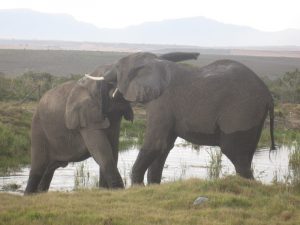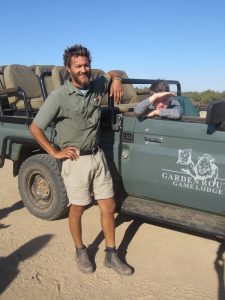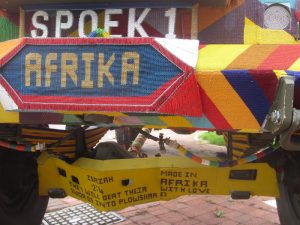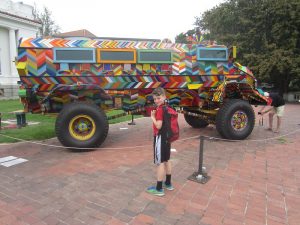One of the first things our guide said to us on our way out of Cape Town was to watch for baboons along the side of the highway. What?!?!? This seemed particularly odd as the scenery around the Cape looks like a cross between eastern Washington and SoCal.
South Africa is a stunningly scenic country, and the atmosphere is electrified by its history of apartheid. Of course there are now glorious monuments to Nelson Mandela, and the statue of notorious racist Cecil John Rhodes has fallen at the University of Cape Town campus, but there are still many inequities in South African society. The townships are still largely slums and it is still mostly white people enjoying the beautiful waterfront areas and manicured neighborhoods.
A small group of us from the ship had a direct encounter with the racist rhetoric that continues to exist in SA. On our trip to a game reserve in the Garden Route area about three hours east of Cape Town, our guide was Afrikaner and told us that there were no black people in South Africa before the Dutch arrived in 1652. Hello? Ever heard of San rock art that dates back millennia?!? The majority of the group was college students, so all of the professors on the trip scurried around making sure the students were aware of the bias the guide exemplified (my students on the trip already recognized it—and were gobsmacked by the guide’s comments). The guide also said there was not much point in going to Robben Island, the place where Mandela spent 18 of the 27 years of his imprisonment… The guides (former prisoners) had heavy accents and were difficult to understand, she said, so why bother. !?!?!?! Our faculty leader for that program made a point of letting the guide know that we had watched the old Denzel Washington classic from 1987, Cry Freedom (about Black Consciousness Movement founder Steve Biko), on the ship in preparation for disembarking in South Africa. The guide literally sneered at the thought (the film was banned in SA).
The animals were magnificent, though.
You should know that art is making a difference for those wanting to come to terms with the country’s apartheid past. Blessing Ngobeni, whom many of you may have met when he spoke on the WWU campus fall of 2015 (thanks to our colleague Monique Kerman), is doing smashingly well with his activist art criticizing the current South African political situation, specifically Jacob Zuma. Blake and I saw an excellent display of post-apartheid art at the South Africa National Gallery in Cape Town, celebrating efforts to promote healing and continuing political activism through visual art. A country this beautiful, with such rich cultural diversity—and excellent wines!—will hopefully be able to rise above its hateful past and make the country a place of health and happiness for all South Africans. Hopefully we can do the same in the US, for all Americans and refugees in our country.





Leave a Reply